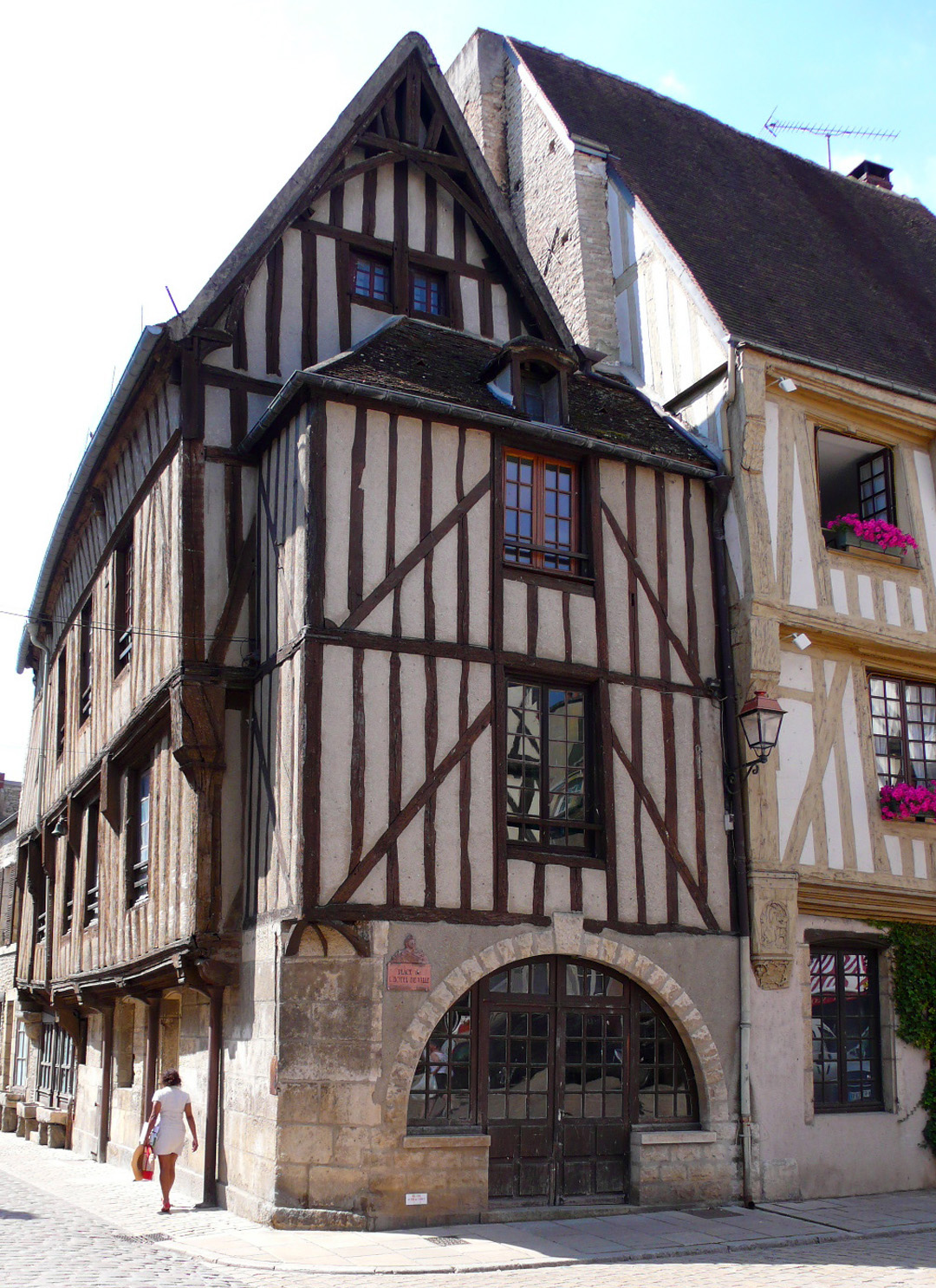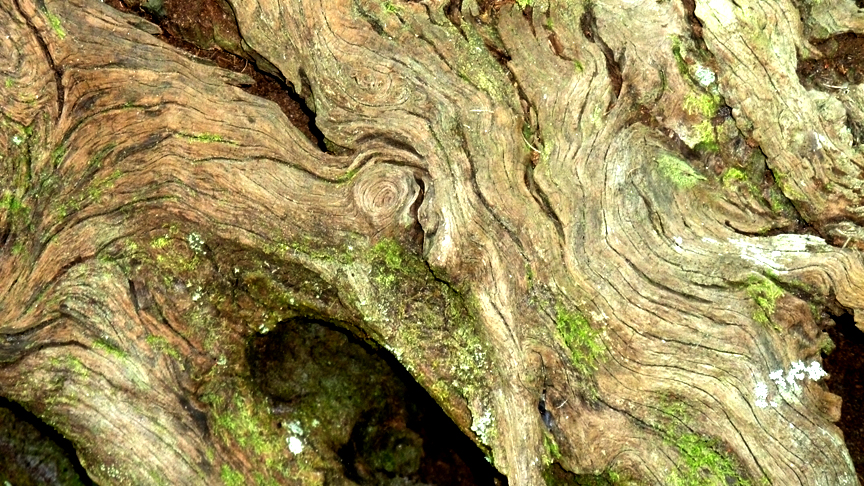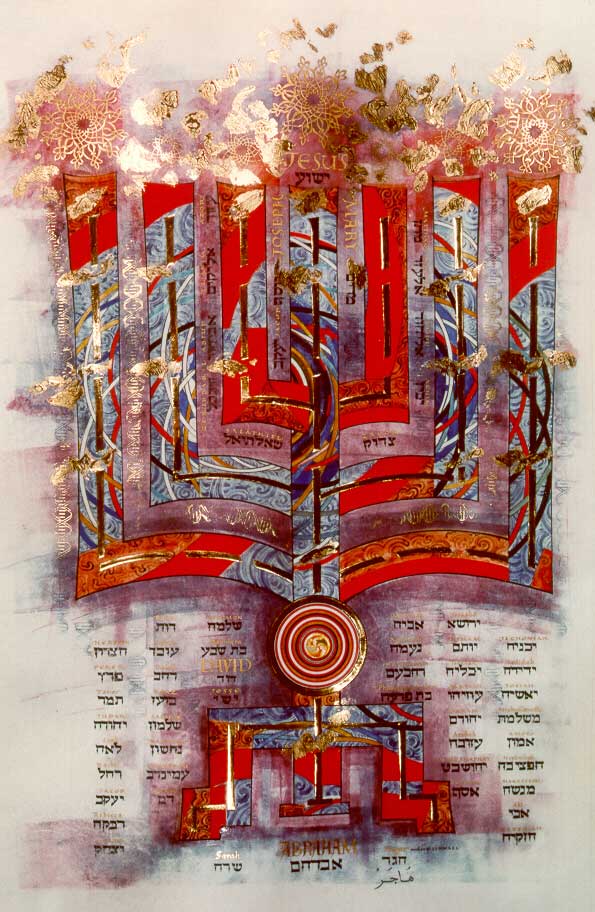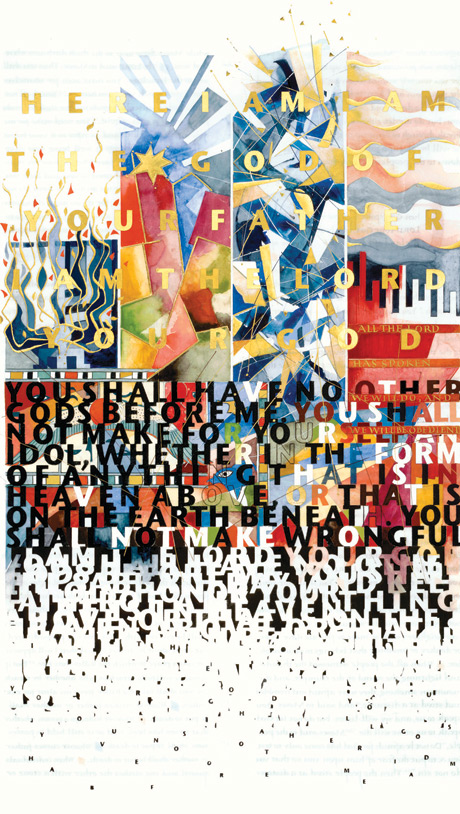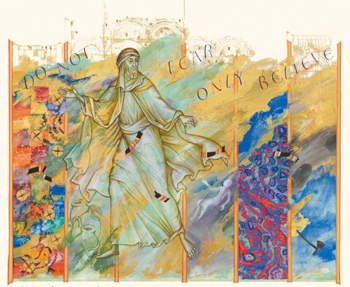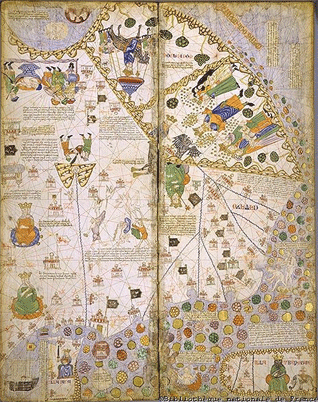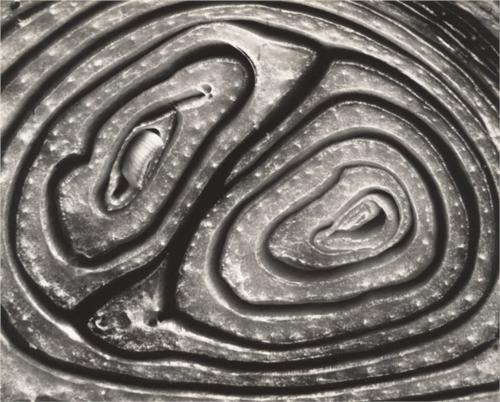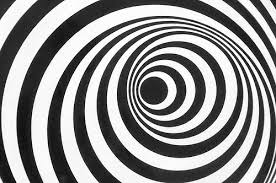I have just received this video that video-maker Derek Gauvain made for me to celebrate metalpoint drawing. Check it out:
Metalpoint
Crowd-Funding with Hatchfund for a Metalpoint-Drawing Residency in Burgundy /
I firmly believe that every artist should be open to new ventures, both in creating art and then in finding ways to reach other people who might share a passion for that type of art. There are always new and potentially fascinating horizons to explore. In that spirit, I have just embarked on a crowd-funding venture with AIM Hatchfund to fund an artist residency at La Porte Peinte, in Noyers sur Serein, Burgundy. All the details are at the Hatchfund website - both in video form and in text form.
Basically I have until 4th July to raise a minimum of $3000 to help defray the costs of going to Noyers to create a body of metalpoint drawings that weave together some fascinating but seemingly disparate aspects of life in Burgundy. Not only was the region a famed centre of monastic production of illuminated manuscripts.
Its renown too as a wine-producing region, thanks to those same industrious monks (and the Romans before them!), is sometimes enhanced by vines planted in soils rich in 150 million year old fossilised minute oyster shells that confer a unique “terroir” hallmark, particularly in the Chablis area.
The link for me in these two facts? Metalpoint drawing. Metalpoint is a medium born in medieval monasteries where monks used lead styli to delineate illuminations and draw the lines for their beautiful manuscripts. After a chequered history, metalpoint is currently undergoing a third renaissance. My passion for this subtle, shimmering medium dates from the early 1980s. I use mainly gold, silver and copper to make marks on prepared paper; the lines cannot be erased, and silver and copper will evolve in colour as they tarnish, making the medium even more alive.
Wine-making, illuminating manuscripts and drawing in silver and other metals are all activities where time has a very different rhythm compared to much of today’s world. We often need reminders that at times, a slower pace of life can bring joy, fascination and quiet rewards. A body of metalpoint drawings can serve as such a reminder.
With those thoughts in mind, I have just uploaded all the required information, video and text to Hatchfund, had the staff approve the contents and make it live. And now I have to hope that other kind people share my optic that travelling though time and different worlds is always fascinating. By making a tax-free donation to this metalpoint drawing project, I would have the pleasure of sending a thank you gift to contributors and then taking them along with me on the path of creating the art, thanks to technology.
Dear reader, share the fun of creation with me!
Transformations /
Transformations from the object an artist is viewing to the art created always seem like magic. No matter how lucid an explanation is given about how the artist gets from point A, the subject matter, to point B, the resultant artwork, there always seems to be another dimension. Perhaps that is because none of us can really get into the head of another human being, no matter how. Each of us is that proverbial "island unto ourselves" and that includes the conscious or subconscious process by which art is created. Of course, there is that other aspect - that the art that happens is also somewhat of a mystery to the artist as well. Each artist really never knows what is going to happen during the art-making process, no matter how carefully the preparation is done, or how meticulously laid out the plan for the work.
Personally, I am learning, slowly, simply to trust that small voice inside my head that says, "look hard at what you are seeing, allow your eye to select the next aspect to draw or paint, and just go with the zeitgeist of that moment of creation." In other words, relax, don't think too hard and work intuitively as much as possible. I have also come to realise, with time, that whether I like it or not, my life experiences, my personality - who I am - will come through my art, for good or for bad.
I was trying simply to live intuitively in the moment last week when I had one of my rare, precious times to draw en plein air. I found an amazing live oak "sculpture" of the remains of a mighty tree - just the stump, the essence of sinews and strength.
The sunlight was shining on parts like a floodlight, and they sang. The only trouble was that of course, the sun moved, the light changed and other parts began to be more visible and the aspects that had interested me simply faded into shadow! Paciencia, as the Spanish say!
Nonetheless, by the end of the time spent in peace and fascination, I had done some small metalpoints. They are a version of this mysterious alchemy of transformations.
Serendipitious Thoughts /
Every artist knows the magic of an idea suddenly hitting when least expected. Often these serendipitous thoughts form the basis on which to create, often something new and adventurous. They help push out new creative frontiers and make one think in different ways. Sometimes it is an idea that reaffirms a direction on which one is embarked already. Other times, it awakens curiosity and suggests new lines of investigation. Let me give an example.
My fascination with silverpoint drawing led me, just recently, to marvel at a displayed copy of the huge and wonderful St. John's Bible. This work of art and devotion was created by a team of artists and theological scholars at the Benedictine St. John's Abbey and University in Collegeville, Central Minnesota, under the leadership of Donald Jackson, Scribe to Her Majesty's Crown Office at the House of Lords in London. Fulfilling a life-long dream of creating a modern illuminated Bible, linking ancient spiritual texts with the 21st century world, he was eventually commissioned in 1998 to create the St. John's Bible. Its final lines were penned in 2011. The resultant, magnificent creation, 2 feet by three when the Bible is open, is written by hand on vellum, with 160 illuminations, each one of which is absolutely mesmerizing. These are just some samples to incite you, I hope, to look at more of them and see them in real life if you get the chance.
I loved looking at the amazing illuminations on display, but behind my fascination lay two questions: Did the artists draw the illuminations out in silverpoint before they painted them with tempera and inlaid gold leaf, as happened in medieval times? And did Mr. Jackson lay out lines on which to write his text with leadpoint, as did the early monks?
I was able to ascertain that no, neither silverpoint nor leadpoint were used in this creation of the St. John's Bible.
So that made me wonder about other frontiers. Now I need to find out about some other amazing creations - the extraordinary portolan charts and nautical maps created in the 14th century by the preeminent Mallorcan map makers, among whom Abraham Cresques and his son, Jehuda, were the most renowned. Since all those early, early maps arose from the monastic tradition of illuminated manuscripts and were often created contemporaneously to the Books of Hours and other sacred works, I suspect that indeed metalpoint came into use during the maps' creation. But I need to hunt further to confirm that.
When you gaze at these complex works of science and beauty, the 14th century equivalent of Google Maps for the seamen of that time, large charts created painstakingly on vellum, it is with the same amazement as I experienced with the St. John's Bible. But now I need to find out if those artists drew their illustrations and lines with metalpoint.
There was something else connected to the St. John's Bible that helped reaffirm ideas that are rummaging around my head for future art projects. The Mission Statement included on the label describing the copy of St. John's Bible on display had a pithy list of actions that are the perfect springboard for serendipitous ideas. Some of them are:
Ignite Imagination Revive Tradition Discover History Foster the Arts Give Voice
All wonderful thoughts of how to go on exploring metalpoint drawing, a medium of antiquity equal to the early medieval religious bibles, of exactitude for exploration of aspects of the natural world and, at the same time, a medium of wonderful possibilities for today's artistic voices.
Evaluating Art /
Changing gears from producing art to matting and framing art for exhibitions is always a bit of a wrench, I find. I don't know if others find it to be so. First of all, of course, it depends on what the exhibition is to be about, and where the show is to be held. An exhibition in a museum is different from one in a gallery where your art is for sale, and the choice of artwork to exhibit will correspondingly be different. Not of less quality, nonetheless. Any professional artist will always try to put the best work out for exhibition, no matter where.
However, deciding on what the "best work" is can be an interesting exercice. I think any artist is always excited about the latest work done, and hopes and believes that it is better than previous work. Nonetheless, I have privately decided that whenever possible, it is good to put the art just completed aside for a while, so that I can then come back to it with a fresh eye. Only then can I have any distance and can better evaluate its merits and/or defects. I sometimes feel a little like the meandering salt water rivers entering the coastal Georgia marshes, such as I painted once.
I am in the throes of trying to do just such an "agonising reappraisal" of work I had put away in a drawer, all carefully stored in mylar envelopes for the metalpoints and acid-free tissue leaving for the watercolours. First of all, I needed to sort through to try to make a coherent ensemble for a solo exhibition I am holding in January-February at the new gallery for Glynn Visual Arts on St. Simons Island, Georgia. Having selected out some art, then comes the more critical, eagle-eyed time. And that is the hard part!
Having winnowed again, the resultant selection has to be matched up with types of mats - 4 ply or 8 ply museum mats. Next come their shades of white and cream (I tend to be super conservative in mat colours, trying to let the artwork speak for itself). Then what type of frame, what colour of moulding? So many decisions. And all part of the evaluation process because until the artwork on paper is matted, glazed and framed, you really do not know how it will finally look.
So I scratch my head a lot, turn the artwork upside down, walk away from it, come close to it. I play light on it (especially for metalpoint drawings because the metals shimmer when you catch them in the correct light and really come alive). I fiddle with mats, mouldings, skin my fingers screwing and unscrewing moulding pieces – such fun!
At the end of this whole evaluation process, which I suspect is familiar, in some form or another, to every artist, one just hopes that the result is an interesting, uplifting ensemble of art that appeals to the public.
Stay tuned for January's news!
A Matter of Timing /
I learned long ago, by hard experience, that when working en plein air, you need to be opportunistic and aware of what is happening around you. Somehow luck and timing often are part of the artistic process!
On a windswept hilltop overlooking wide Burgundy plateaux of ploughed fields and neat vineyards, I was deep into drawing a small goldpoint.Ii was trying to be mindful of Matisse's dictum: "one must always search for the desire of the line, where it wishes to enter or where to die away." That wisdom seems so appropriate when drawing in metalpoint, with the ability of the stylus to state its own terms about energetic moments and those when it fades away to a whisper.
I suddenly became aware of the roar of a mighty behemoth of a tractor approaching. I happened to be parked at the edge of a field of barley stubble, as I had become fascinated by the random patterns of the chaff and stubble half lying, half standing after the harvest. The tractor got closer and closer.
I was just trying to decide if I had finished the drawing or not when I glanced up. The monstrous machine was heading straight for my part of the field and the farmer atop his giant tractor was looking hard at me!
I hastily moved right out the way and waved my apologies to him. He nodded, lowered his plough, and before I could count to ten, my barley stubble was no more. Instead, rich russet soil was being churned up in powerful furrows, the first move in the every-renewing cycle of life in the farming world of cereal cultivation.
My timing was impeccable. There were no other fields left of cereal stubble visible anywhere. I had managed to find the last field to be ploughed. In essence, I had more than followed Matisse's idea of finding where the line wishes to enter or die away. The plough was the guiding factor! Or in other words, carpe diem works in art too!
Echoing Joan Miró's Wisdom /
Joan Miró
The Fundacion Pilar I Joan Miró a Mallorca is a wonderful place in which to spend a hot summer morning. From the sunswept terraces that overlook the brilliance of the Mediterranean to the cool, diffuse light of alabaster screens in the exhibition spaces, all the senses are awakened by unexpected juxtapositions of interest and beauty. Rafael Moneo designed the exhibition spaces as a complement to Miró’s studio and Pilar and Joan Miró’s home. Gardens and reflecting pools are glimpsed from the building through often low windows, enhancing the building’s spaciousness and its spare simplicity.
In a way, the buildings follow a concept that Miró enunciated about his paintings in black and white. Writing in 1959, Miró said, “My wish is to achieve maximum intensity with minimum means”. Many of his paintings verge on the oriental in many ways during this period.
His desire to use an intense but spare vocabulary in monochromatic work resonated with me, for increasingly, that is what interests me in my metalpoint drawings. How to say a lot in a condensed or powerful fashion, using the minimum of means. In truth,metalpoint is such a simple, humble drawing medium: just a piece of metal, making marks on a smooth surface prepared with a ground. Its range of tones is limited, its scale often limited because of the slowness of execution, its discipline of technique demanding. Yet despite all that, like Miró’s black and white paintings, metalpoint at its best is quietly powerful. Its lustre is alluring and unusual, its economy of form arresting.
One of the masters of silverpoint/metalpoint was of course Leonardo da Vinci. He led the way in the maximum impact-minimum means league.
Another silverpoint artist working today with a very different approach is Roy Eastland, a British artist. Nonetheless, to my eye, he is highly successful in the impact he achieves with the humble medium of silverpoint.
One of my minimalist recent metalpoint drawings owes its origins to the patterns I saw recently on a huge plane tree one hot July day in France.
Colour versus Black and White /
When you are surrounded by brilliant, sunlit hues and above the sky is blindingly blue, it is easy to be captivated by colour and want to translate it into your art. We all resonate to colour, and it is and always has been the dominant approach to painting. Nonetheless there are those, artists and art lovers, who also resonate to black and white and shades of monochrome in between.
I read of a perfect summation of this difference in an El Pais article about the resurrection of the Leica camera, once considered the ne plus ultra of 35 mm. cameras for most of the 20th century. Every great photographer, from Capra to Henri Cartien-Bresson used a Leica because it was quiet, highly portable and had remarkable lenses that allowed fantastic photographs to be taken. Cartier-Bresson believed too that all edits to the image should be made when the photo was being taken, not afterwards in the darkroom.
Until the digital camera came along, Leicas were much esteemed. When the then nearly bankrupt company was bought out in 2005 by Andreas Kaufmann, heir to an Austrian paper company fortune, a fascinating development occurred. Andreas Kaufmann gambled on differentiating Leicas from all other digital cameras: the M Monochrom Leica only takes black and white images. When this Leica was launched in May 2012, the model was priced at a cool 6,800 euros. It has become a runaway success in the photographic world, selling like hot cakes through Leica Boutiques around the globe.
As Andreas Kaufman was quoted as saying, “For me, colour is more emotion, while black and white represents structure.” The remark resonated with me.
True, I was brought up with a grandfather and mother both photographing in black and white in East Africa. In fact, they were so successful that they kept the farm going on photographic sales during the dreadful Great Depression years when the farm was in its infancy and barely sustained them as a family. I have always considered black and white photographs of the 1930-50 era in Europe as marvellous works of art, as well as the amazing photographs that Edward Weston and Ansel Adams took in the earlier 20th century.
I also love black and white drawings for their immediacy and unadorned truth of execution. Look at this one for direct simplicity and power of composition.
Even black and white paintings have an impact that indeed speaks of structure and logical thought.
It is as if you can get your teeth into a black and white work of art, while one in colour is a fraction fuzzy, tugging at emotion and heart strings. Portraits, landscapes, even still life or abstracts: they all evoke passion, sympathy, joy, sorrow, lyricism. Black and white images seem more cerebral, more challenging often. I find it logical that I am more and more fascinated by metalpoint drawing – it is all back to black and white.
Plus ça change, plus ça reste la même!
Changing Gears in Art /
Now that some time has elapsed since I finished my residency at DRAWinternational in France, I find I am still thinking about how to change gears. I went there on the premise that I wanted to explore the option of working on a larger scale in metalpoint, especially metalpoint on a black ground.
Setting out on a new path in art-making always takes time for one to readjust, I know. It has happened to me before, but this time, other issues in life have complicated the "digestion period". You have to filter all the advice, new thoughts and suggestions, new concepts, and try to decide which road to take and how.
This was one route, one way of changing gears, using graphite instead of metalpoint.
This was another experiment in graphite.
Eventually, I wanted to return to metalpoint, so I started trying to work larger and adjust - at least a little.
I am still going back and forth in my mind about the direction I want now to follow, but I know that the residency was good for me, jolting me out of ruts.
I am at the stage where I can look back on the work I did in France and join philosopher R. G. Collingwood as he talked of his own artistic upbringing. He said, "I learned to think of a picture not as a finished product exposed for the benefit of virtuosi, but as a visible record of an attempt to solve a definite problem in painting, so far as the attempt has gone." For me, the operative words remain, "as far as the attempt has gone". Still more changes to come, I hope!
Talking about Silverpoint /
It has been a while since I could get to this blog – mainly because I am back for the second half of an art residence at DRAWinternational in France, and there is a certain fever of creativity.
No comments on whether the results are good or bad!
But the days fly past with the privileged situation of only requiring that one thinks about art, how to do something that pushes out boundaries and grow. Such luck! Nonetheless, there is the more serious side of the residency, namely giving and talk and demonstration to the public.
Of course, I suggested that I talk about my passion, metalpoint-silverpoint, and then had to spend some time putting together a serious survey of the history of this medium. That is always a fascinating exercice, and it reminds me how many different voices there have been and are today in this rather restrictive medium of drawing with a metal stylus on prepared paper. Selecting examples of contemporary metalpoint to show my audience how varied, elegant and imaginative are the silverpoint voices drives home to me what a special medium this is.
This is the poster/invitation to Sunday’s presentation – which I will give in French.
Poster for my Talk on Metalpoint at DRAWInternatioonal
Meanwhile, I draw and draw, experiment and try to balance long hours of sitting with vigourous walks up hill and down dale in this delicious medieval village of Caylus. The weather is totally unlike usual Mediterranean September weather, in that it is distinctly chilly.
No matter, another layer on and get down to drawing! In other words, vive l’art and art residencies!

